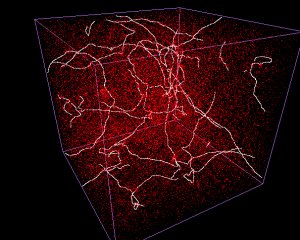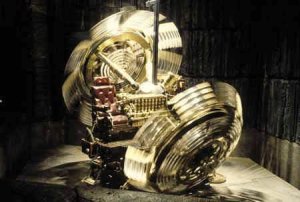
Time travel is hard. Really hard. In fact, in ancient ages, most people believed that it was entirely impossible. Time was seen as just a linear series of events. Cause and effect– that was the order of things, and it could not be changed. However, as our understanding of the universe advances, we come up with new hypotheses about what *could* be. As such, we develop more and more theories related to time travel. Here are just a few of them…
Infinite Cylinder
Proposed by astronomer Frank Tipler, this mechanism would allow very advanced civilizations (very, very, very advanced civilizations) to travel through time. For this cylinder to work, you will need matter that is roughly 10 times the sun’s mass (so A LOT of matter). Then you will need to roll this matter into very long and very dense cylinder. And I mean *very* dense. This super-dense cylinder would be a bit like a black hole that has passed through a spaghetti factory (so you can imagine the technology that would be needed to create this density).

The key to this device is its spin. Tipler argued that a cylinder might produce closed time-like curves if the rotation rate were fast enough—at least a few billion revolutions per minute. Once the cylinder is rotating fast enough, a spaceship nearby (if it follows a very precise spiral around this cylinder) could possibly travel billions of years into the past and several galaxies away. However, Stephen Hawking proved that time travel would not work with a finite cylinder unless you have negative energy (rather unlikely). But there is hope! It would be possible if the cylinder is infinitely long.
To summarize: You need to essentially create a black hole in the shape of a cylinder. You need to make this super massive, super dense object rotate a billion times a second. It needs to be infinitely long. So saying that this theory is going to be a little hard to put into practice is a bit of an understatement.
Black Holes
Another possibility would be to move a ship rapidly around a black hole (traveling near the speed of light). Because black holes are so massive, they warp space-time. As such, time passes more slowly for those who are near a black hole. Scientists estimate that individuals could feasibly get close enough so that time is cut in half – 10 years for the universe would be 5 years for the time travelers.

According to Hawking, “Around and around they’d go, experiencing just half the time of everyone far away from the black hole. The ship and its crew would be traveling through time. Imagine they circled the black hole for five of their years. Ten years would pass elsewhere. When they got home, everyone on Earth would have aged five years more than they had.” So it’s not exactly a huge transition, but you could slow time down a bit.
I know, I know. This may not sound all that awesome.
I mean, it’s not like you would be going back to see the dinosaurs or meet your great-great-great-great-great-great grandparents. However, it would be handy if you had a terminal illness; you could slow time down and wait for the rest of the universe to find a cure.
To Summarize: You need to travel around the speed of light (we don’t have the technology to withstand these forces). You need to actually get to the black hole, the closest of which is light-years away (which would take generations to reach). So, like the last example, this is rather beyond our grasp.
Cosmic Strings
Proposed by Tom Kibble in the 1970s, another theory for potential time travelers involves something called “cosmic strings.” These are hypothetical 1-dimensional narrow tubes of energy that are stretched across the entire length of the ever-expanding universe. Ultimately, the cosmic strings are believed to be left over from the early cosmos. And they are predicted to contain huge amounts of mass. Since they contain so much mass, they could warp the space-time around them.

It is expected that at least one string per Hubble volume is formed (a Hubble volume is a spherical region surrounding an observer beyond which objects recede from that observer at a rate greater than the speed of light due to the expansion of the Universe). Moreover, cosmic strings are either infinite or they’re in loops, with no ends, scientists say. The approach of two such strings parallel to each other would bend space-time so vigorously (and in such a particular configuration) that might make time travel possible.
To Summarize: Very, very few cosmic strings (there might be just one or two in the entire observable universe, which has a 93 billion light-years diameter). These two strings would need to be rather close together. A rather unlikely scenario.
Time Machines
Time machine research often involves bending space-time so far that time lines turn back on themselves to form a loop, technically known as a “closed time-like curve.”

To accomplish this, time machines are thought to need an exotic form of matter with so-called “negative energy density.” Such exotic matter has bizarre properties, including moving in the opposite direction of normal matter when pushed. Such matter could theoretically exist, but if it did, it might be present only in quantities too small for the construction of a time machine.
However, time-travel researchers suggest that time machines are possible without exotic matter. The work begins with a doughnut-shaped hole enveloped within a sphere of normal matter. Inside this doughnut-shaped object, space-time could get bent upon itself using focused gravitational fields. To go back in time, a traveler would race around inside the doughnut, going further back into the past with each lap.
To Summarize: We need to find A LOT of exotic matter, which we’re not even sure exists. We’d need to do A LOT of running around the inside a doughnut-like object. Too many hypotheticals and too much running for me.
—————————-
There are other theories. But no matter which you look at, it seems that time travel is not exactly possible. At least, we currently don’t have the technology to make the necessary devices, and we also lack the technology to get to the naturally occurring objects (like the black hole or cosmic string). And even if we could make such devices or to travel to such places, survival is rather unlikely.
However, the field is constantly changing and new things are constantly being discovered…so here’s to hoping.
FQTQ is managed by two people, Jaime and Jolene. We want to make science fun and engaging. We’re doing that. With your help, we can do even more.
Below you can support us, get to know us, and access extra content: